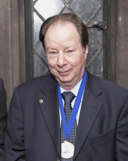Sidney Altman facts for kids
Quick facts for kids
Sidney Altman
|
|
|---|---|

Altman in 2011
|
|
| Born | May 7, 1939 |
| Died | April 5, 2022 (aged 82) Rockleigh, New Jersey, U.S.
|
| Nationality | Canadian, American (since 1984) |
| Alma mater | MIT, University of Colorado at Boulder, Columbia University, Arizona State University |
| Known for | Ribozymes |
| Spouse(s) |
Ann Korner
(m. 1972; div. 2018) |
| Children | 2 |
| Awards | Nobel Prize in Chemistry (1989) Lomonosov Gold Medal (2016) Rosenstiel Award (1988) |
| Scientific career | |
| Fields | Molecular biology |
| Institutions | Yale University Cambridge University Harvard University |
| Thesis | Bacteriophage T4 DNA replication in the absence and presence of 9-aminoacrine (1967) |
| Doctoral advisor | Leonard Lerman |
| Doctoral students | Benjamin C. Stark, Robin Reed |
Sidney Altman (born May 7, 1939 – died April 5, 2022) was a scientist who studied molecular biology. He was a professor at Yale University. In 1989, he won the Nobel Prize in Chemistry. He shared this award with Thomas R. Cech. They won for their important work on how RNA can act like an enzyme.
Early Life and School
Sidney Altman was born in Montreal, Quebec, Canada, on May 7, 1939. His parents, Ray and Victor Altman, had moved to Canada from Eastern Europe in the 1920s. His mother worked in a textile factory. His father ran a small grocery store.
Sidney learned from his parents that hard work pays off. Their efforts allowed him to go to college. He moved to the United States to study physics at the Massachusetts Institute of Technology (MIT). He even played on the ice hockey team there!
After getting his first degree from MIT in 1960, Sidney continued his studies. He went to Columbia University and then to the University of Colorado. At the University of Colorado, he earned his Ph.D. in biophysics in 1967. His research looked at how certain chemicals affected the DNA of a virus called bacteriophage T4.
In 1972, Sidney married Ann M. Körner. They had two children, Daniel and Leah. Sidney lived in the U.S. for most of his life. He became a U.S. citizen in 1984, but he also remained a Canadian citizen.
His Scientific Work
After getting his Ph.D., Sidney Altman did more research. He worked at Harvard University and then in Cambridge, England. In England, he began the work that led to his big discovery. He studied something called RNase P.
RNase P is a special particle found in cells. It helps make tRNA molecules ready for their job. Scientists used to think that only the protein part of RNase P did the work. But Sidney Altman and his team found something amazing. They discovered that the RNA part of RNase P could also act like an enzyme.
This was a huge discovery! Before this, everyone thought only proteins could be enzymes. Enzymes are like tiny tools that speed up chemical reactions in living things. Sidney Altman showed that RNA could do this too. This special type of RNA is now called a ribozyme.
In 1971, Sidney Altman became a professor at Yale University. He continued his research there. He became a full professor in 1980. From 1985 to 1989, he was the Dean of Yale College. His discovery about RNA acting as an enzyme earned him the Nobel Prize.
Awards and Recognition
Sidney Altman was recognized for his important work. He became a member of the American Academy of Arts and Sciences in 1988. In 1990, he joined the National Academy of Sciences and the American Philosophical Society. These are groups that honor top scientists.
Later Life
Sidney Altman passed away on April 5, 2022, in Rockleigh, New Jersey. He was 82 years old.
See also
 In Spanish: Sidney Altman para niños
In Spanish: Sidney Altman para niños
- History of RNA biology
- List of RNA biologists

